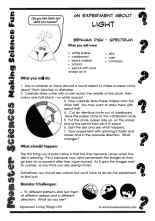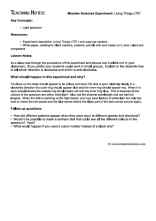Could it be magic? How does spinning a black and white disk create colours?
 |
 |
A Monster Sciences Experiment About: Light – Benham Disk – spectrum of light
What you will need:
• white paper
• cardboard
• black marker
• scissors
• pencil with and eraser on it
• pins
• ruler
• compass
What you will do:
1. Use a compass or trace around a round object to make a paper circle about 10cm (4inches) in diameter.
2. Carefully draw a line with a ruler across the middle of the circle, then colour one half black – no white spaces!
3. Now carefully draw these shapes onto the other half. You may want to draw them with pencil first!
4. Cut an identical circle out of cardboard. Glue the paper circle to the cardboard circle.
5. Put the circle, paper side up, on the eraser end of the pencil then pin it in place.
6. Spin the disk and see what happens.
7. Now experiment with spinning it faster and slower and in the opposite direction. What changes?
What should happen:
The first thing you should notice is that the lines become circles when the disk is spinning. This is because your mind remembers the images as they go past for a moment after they have moved. As it spins the images start to overlap, so you think you are seeing circles.
Sometimes you should see colours but you’ll have to do do the experiment to find out!
Monster Challenges:
• Try different patterns and test them at different speeds and in different directions. What do you see?
Teaching Notes: Monster Sciences Experiment: Light L07
Key Concepts:
• Light spectrum
Resources:
• Experiment description Living Things LT07 – one copy per student.
• White paper, cardboard, black markers, scissors, pencils with and eraser on it, pins, rulers and compasses
Lesson Notes:
As a class read through the proceedure of this experiment and discuss how it will be run in your classroom. If you prefer your students could work in small groups. Explain to the students how to tell which direction is clockwise and which is anti-clockwise.
What should happen in this experiment and why?
The lines on the disks should appear to be cirlces and when the disk is spun relatively slowly in a clockwise direction the outer ring should appear blue and the inner ring should appear red. When it is spun anti-clockwise the outside ring should seem red and the inner ring blue. This is because all the colours of the spectrum are within white light – blue has the shortest wavelength and red had the longest. When the sidk is spinning at the right speed, your eye sees flashes of white light but only has time to notice the red waves and the blue waves before the black part of the disk comes around again.
Follow up questions:
• How did different patterns appear when they were spun at different speeds and directions?
• Would it be possible to make a benham disk that could see all the different colours in the spectrum? How?
• What would happen if you used a colour marker instead of a black one?



